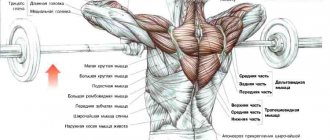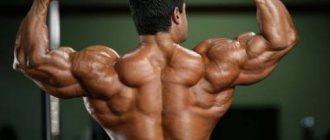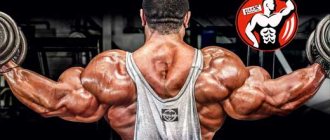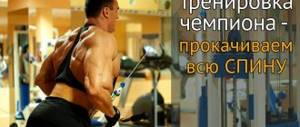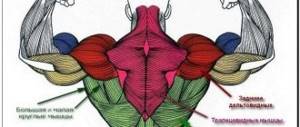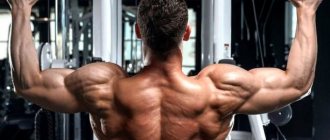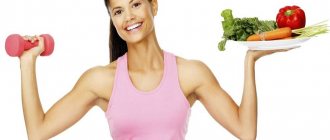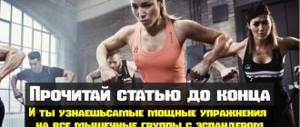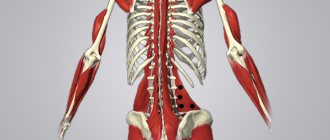Knowledge of the anatomy of the back muscles is an important component in its training. Any professional athlete knows this, which is why they have a large and massive body. If your goal is to achieve good results in bodybuilding, then take the time and read this article. The back is one of the large muscles and occupies the entire back of the body. Thanks to it, we can keep the body straight and upright. Also, many spinal muscles perform various functions, from holding the spine to moving the arms and head and protecting the spine from heavy loads. They enable us to walk, bend and sit, while maintaining correct posture. Therefore, we can conclude that the back muscles should be well developed and are in the forefront when drawing up a training program.
Location and main functions of the back muscles.
We have already found out that good development of the back muscles is very important. Now let's look at what muscles these are, where they are located and what functions they perform.
Conventionally, the back can be divided into several zones:
- Scapular. This area is located above the surface of the shoulder blades and attached to the 6th cervical vertebra.
- Subscapular. This area is located under the shoulder blades on both sides of the spine (left and right).
- Vertebrate. It starts from the head and ends in the pelvic area.
- Lumbar . Located in the lumbar region. It is located perpendicular to the spine.
- Sacral . Located above the sacrum. Located parallel to the spinal column.
Anatomy of the back muscles
Also, due to the way these muscles are located, they can be divided into two types:
Superficial
These muscles are very clearly visible, as they are located on the surface. It is for their development that bodybuilders devote the most time, since the result is clearly visible. At one edge they are attached to the long processes of the spine. They resemble small tubercles and can be easily felt in the area of the spine. The other edge is attached to the shoulder girdle, ribs, shoulder blade and pelvis. Depending on which area of the back we are talking about.
Deep muscles
They are also called internal. They are located deep under the superficial muscles. They originate from the skull and end in the area of the coccyx. They are attached to the short processes of the spine, thereby forming a muscular corset, from the head to the sacrum, which envelops the spine on all sides. They are mainly included in the group of spinal straighteners. Therefore, they are very important when working with heavy weights. Their good development also affects the appearance of the back.
Contraindications for use
Like other types of physical activity, exercises for the latissimus dorsi muscles have absolute and relative contraindications. Despite the direct dependence of an athlete’s well-being on the strength and endurance of the latissimus muscles, practicing this type of training is highly not recommended for people who have.
Scroll:
- malignant neoplasms (an increase in the speed of blood flow when stimulating metabolic processes during strength training helps to “feed” the tumor, which in the vast majority of cases leads to its rapid increase);
- diseases that involve systematic use of medications that have a direct effect on the functioning of the musculoskeletal system;
- mental disorders;
- inguinal hernias;
- hernias and protrusions localized in the spinal column;
- arthrosis of joints and bones;
- dysfunction of the cardiovascular system;
- hypermobility of the shoulder joints.
The most common relative contraindications to working out the latissimus dorsi muscles are:
- pregnancy;
- ARVI or acute respiratory infections;
- increased body temperature;
- exacerbation of chronic diseases;
- menstruation;
- rehabilitation period after a stroke (first 6 months after the attack);
- recent surgical intervention, regardless of the specifics of the operation (first 6-8 months);
- infectious lesions of the skeletal system (in particular, the consequences of which are inflammatory processes in the joints).
If an athlete has one or more relative contraindications from the list, it is recommended to consult a doctor to determine the period after which the existing restriction for playing sports will be lifted.
Superficial muscles
These include the largest muscles and many exercises in the gym are aimed at developing them.
Trapezoid
This is a large flat muscle located on the surface of the back. It has two halves of a triangular shape, and when folded together they create a trapezoid. It covers almost the entire upper back. It starts from the back of the neck and attaches to the shoulder blades and collarbone. Conventionally, it can be divided into three parts.
- Upper. It is located in the scapular part of the back. One edge is attached to the occipital bone and all cervical vertebrae. The other edge attaches to the outside of the collarbone.
- Average. Also located in the area of the scapular region, under the upper part. It originates from the thoracic vertebrae from the 1st to the 4th. Next, attach to the lateral (upper) edge of the scapula.
- Bottom. It is located in the subscapular region. Attached to the long processes of the thoracic vertebrae, from the 5th to the 12th. And the other edge to the medial end of the scapula. Or rather, to the tubercle located on it.
You can learn about methods of training the trapezius from the article: The best exercises for the trapezius
Functions:
Working in two halves brings the shoulder blades closer to the spine. The upper part is involved in stabilizing the neck and helping to tilt it back. This part also raises. Shoulder blades up. And the lower part lowers it. This results in the raising, lowering and rotation of the arms. Straining separately, the left and right parts turn their heads, each in their own direction.
Latissimus muscles
These are the favorite muscles of many bodybuilders. It is on their development that bodybuilders spend all their energy. Many newcomers, when they come to the gym and say that they want to pump up their back, mean these muscles. Their good development makes your back visually larger and gives it a V shape. If you look from the front, you can see how this muscle protrudes in the armpit area. They are located in the lower back. The lats are covered from above by the trapezium and end in the pelvis area. The upper part covers the lower angle of the scapula. Going around this angle, it is attached to the crest of the lesser tubercle of the humerus. And from below it is attached to the long part of the thoracic vertebrae from the 6th to the 12th. Also to all lumbar vertebrae, to the sacrum (lower part of the pelvis) and to the iliac crest (pelvic bones). The other edge is attached to the lower 5 ribs.
Function:
Moves and extends shoulders. When the arms are fixed, the body is pulled towards them (rope climbing, pull-ups). It also fixes the position of the pelvis and torso. Also involved in lateral bending.
Rhomboid major and minor muscles
This muscle is located under the trapezius, but is also superficial. It connects the shoulder blades to the spine and to each other. The large rhomboid is attached to the 1st to 5th thoracic vertebrae, with the other edge to the lower part of the scapula. And the small one is attached to the 1st to 2nd cervical vertebrae. And the other edge to the top of the same shoulder blade. Although the functions of these muscles are not very numerous, the tasks they perform are important.
Function:
One of the main functions is to stabilize the scapula. If this muscle is weak, the back will take on a stooped appearance. The large rhomboid is involved in the movement of the scapula up, forward and backward. And the small one helps the shoulder blade rotate.
Levator scapulae muscle
It is located under the trapezoid. This is a small muscle, but it is the second most important after the trapezius in terms of contraction frequency. That is, she very often gets involved in the work. Attached at the upper end to the first 4 cervical vertebrae. The lower edge attaches to the inner upper corner of the edge of the scapula, as well as to the middle section.
Function:
Raises the shoulder blade up.
Consolidate the result
In addition to regularly performing strength exercises to work the latissimus dorsi muscles, qualified fitness trainers recommend strengthening the muscle corset with help.
Scroll:
- simple gymnastics (such exercises should be practiced in the morning immediately after waking up);
- controlling posture (especially important for people whose main occupation involves spending a long time sitting at a table);
- periodically changing body position during the day (if work requires standing, it is important to spend a break sitting and vice versa);
- compliance with the rules of weight distribution when rising from a chair (most of the load should be distributed on the lower limbs, not the back);
- compliance with the rules for long trips by transport (for example, during a multi-hour trip by car, you should make stops once an hour to stretch your legs and redistribute the load on your back);
- choosing the right items for sleeping (the mattress should be of medium hardness, the pillow should be thin and small);
- regular (once every 5-6 months) course (at least 10 procedures) of professional back massage (massage must be performed by a specialist with a medical education, implying knowledge of the basic physiology of the human body).
The above recommendations will not only help consolidate the results achieved during training, keeping the latissimus muscles in good shape, but will also contribute to the correct distribution of the load on the back. Uniform tension minimizes the likelihood of spinal disc wear and also has a positive effect on a person’s posture.
Deep back muscles
These muscles are aimed at maintaining the spinal column. They are located under the superficial muscles, so we do not see them. Also, some of them are responsible for posture and supporting the head.
Erector spinae muscle
The erector spinae muscle (transverse spinalis) is the longest and strongest muscle in the back. It runs along the entire length of the spine, from the head to the pelvis. It is constantly under load, as it keeps our back in a straight position. Thanks to this, we can walk on two legs. The muscle originates from the inner (dorsal) surface of the sacrum: the long and short processes of the lower back. It is also attached to the 8-9 ribs (lumbothoracic fascia). And then it reaches to the back of the head. The lower bundles of this muscle strengthen the ribs, thereby creating a strong support for the diaphragm
It can be divided into 3 parts, depending on the place of attachment:
- The iliocostalis muscle is attached to the ribs. It is the lateral part (lateral, further from the axis of the spine).
- Longissimus muscle - attaches to the transverse (long) processes of the lumbar spine. Located in the middle part, closer to the head. Located between the iliacus and brevis muscles.
- Short muscle (spinalis) - attached to the short processes of the spine. Located medially (closer to the axis of the spine).
Training for a beginner
Pull-ups
- 3 sets of 10 reps
- Body Part: Lat Equipment: Bodyweight
Bent-over barbell row
- 2 sets of 10 reps
- Body Part: Press Equipment: Barbell
Attention, if you chose negative pull-ups, also perform three repetitions. Every two workouts you can increase the number by 1 pull-up.
Add to Calendar * Add to My Workouts * Print Workout
* — The service is in beta testing
This workout will be great for beginners. It should be done 2 times a week, at the very beginning of the training.
There are also muscles on the back that are involved in breathing by raising and lowering the ribs.
Serratus posterior superior
This muscle is superficial. It is located under the rhomboid muscles. It starts from the ligaments of the 2 lower cervical vertebrae and the 2 upper thoracic vertebrae. It goes down and is attached to the ribs from 2 to 5 ribs. Depending on the training of the muscles, the number of their bundles may vary or be absent altogether.
Functions:
It lifts the ribs to which it is attached, thereby helping to inhale.
Serratus posterior inferior muscle
The muscle is located in the area of transition of the thoracic to lumbar spine. It originates from the 2nd or 1st lower thoracic vertebrae and the 2nd or 3rd upper lumbar vertebrae. It is directed diagonally upward and attached to the 9th to 12th rib.
Functions:
Lowers the ribs, participating in the act of exhalation.
Pain in the lower back muscles near the spine
Any pain in the lower back muscles is a danger signal from the body. If, due to excessive stress, a spasm of blood vessels occurs, then the myocytes begin to experience a serious lack of fresh arterial blood supply. This leads to ischemia. If blood microcirculation in the capillary network is not restored in time, an ischemic reaction will develop. Against this background, massive necrosis of myocytes can begin. Future death of muscle tissue can lead to the formation of rough scars through which electrical nerve impulses cannot pass. This causes the development of fibromyalgic pain syndrome.
If the muscles of the lower back near the spine hurt due to osteochondrosis, then this is no less dangerous condition. Overstrained muscles block the flow of fresh arterial blood. They also slow down the drainage of lymphatic fluid from the lesions. Therefore, with osteochondrosis and the pain syndrome developing against it, it is also necessary to eliminate muscle spasms as quickly as possible and restore microcirculation of blood and lymphatic fluid.
Pain in the lumbar back muscles can be compensatory. Due to excessive tension of the muscle fiber, the body tries to relieve excess pressure from the radicular nerves in case of serious subsidence of the height of the intervertebral disc. In this situation, taking muscle relaxants is extremely dangerous. Due to sudden muscle relaxation, injury to the radicular nerve can occur. This will entail a disruption of the innervation of certain parts of the human body.
If you have severe pain in the lower back muscles, avoid self-diagnosis and treatment. Be sure to consult a doctor for qualified medical care.
Exercises to develop back muscles
Any muscle group can be developed, and the back muscles are no exception. The best way to cope with this is with special targeted exercises. Of course, for each person the effect of them will be purely individual, so it is worth choosing those that are most useful for you.
There are basic exercises that strain the entire back and isolated ones that target only a specific muscle.
Basic exercises
Deadlift
This is the best exercise for developing the back, as it involves all the muscles (latissimus, trapezius, rhomboid major and minor, splenius muscles of the neck and all the erector spinae muscles). It is a must-do for both beginners and professionals.
Pull-ups on the bar
This exercise is perfect for developing the latissimus dorsi muscles, or rather their width, both the rhomboid major and minor. The muscles of the arms and shoulders will also receive a load, but for us this is not so important now. Also, by changing the grip from narrow to wide, you can change the degree of impact on the back muscles. I advise you to experiment with this and find the optimal grip for you. You can do pull-ups either with your own weight or using weights in the form of pancakes, dumbbells, and weights.
Bent-over barbell or dumbbell row
These two options are also basic, aimed at developing the latissimus dorsi muscles, or rather their thickness. Also, all deep muscles are statically loaded to keep the spine and neck in an even position.
Shrugs with a barbell or dumbbells
This is a specialized exercise for developing the trapezius muscle. Experiment with weights and grips, then you can find the right option for yourself.
Pullovers with dumbbells
Some believe that pullovers are aimed at developing only the pectoral intercostal muscles. But that's not true. The movement itself also involves the latissimus dorsi muscles, and the lower and upper serratus muscles. Therefore, we also include it in our back training.
Isolated exercises
Vertical pull of the upper block
This is a simpler version of pull-ups. It is performed in a special block simulator. You can use different handles, narrow, wide and a handle with a parallel grip. This will also change the area of action on the back muscles and increase or decrease the range of motion. There is also a one-handed option. I work the latissimus dorsi and rhomboid muscles.
Lower pulley to the waist
The lat pull-down is an isolated exercise similar to a bent-over barbell or dumbbell row. Only
Exercises for the lower back on the machine
Hyperextension
Hyperextensions are suitable for beginners and those with weak backs. This exercise does not overload the spine and joints and maintains muscle tone.
- I.p. – lying on the machine on your stomach, secure your heels under a special cushion.
- Bend down and slowly rise until your body resembles a straight line. Stay in this position for 2-3 seconds. Make sure that there is no strong arching in the lower back. Return to i.p.
Do 10-12 repetitions for 3-4 sets.
Reverse grip barbell row on the Smith machine
Thanks to this grip, the biceps work more actively and the lower back muscles receive more load. You should tilt at about a 45º angle, using your legs and hips a little when lifting heavy weights. Do 8-10 repetitions for 3-4 sets.
One-arm barbell row using a Smith machine
- I.p. – standing sideways to the exercise machine. Grip the bar in the center, one leg slightly behind, knees bent.
- Try to pull the bar as high as possible.
Do 8-10 repetitions for 3-4 sets.
It is not at all necessary to include all of the listed exercises in your workout. It will be enough to do 2-3 exercises to pump up the muscles, but in a high-quality manner. And then you will have a sculpted back, and your muscles will be strengthened.
Alexandrova Anastasia
Nutrition and healthy lifestyle specialist and author of myfitnesblog.com. For many years, she has successfully helped women and men lose weight and maintain a beautiful figure.
